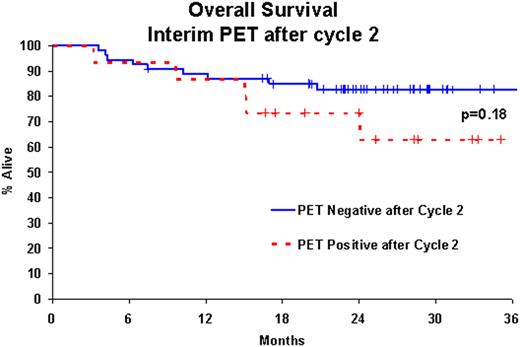Abstract
Abstract 137
FDG-PET/CT after 2–4 cycles of chemotherapy has been shown to be predictive of outcome in patients with aggressive lymphoma. This multicenter NCCTG phase II study was carried out to assess efficacy of ER-CHOP in newly diagnosed DLBCL; functional response as measured by FDG-PET/CT was done after 2 cycles and after 6 cycles of therapy.
Patients received immunochemotherapy on the following schedule: epratuzumab 360 mg/m2, rituximab 375 mg/m2, and standard dose CHOP every 3 weeks for 6 cycles. FDG-PET/CT was done after 2 cycles and again after 6 cycles of therapy. All PET scans were centrally reviewed by an expert in nuclear medicine who was blinded to the outcome of the patients.
107 patients were accrued from Feb 2006 to Aug 2007. 27 patients were ineligible resulting in 80 eligible patients. Baseline patient characteristics for the eligible patients included median age 60 (range 21–82); 56% were male. 80% had advanced stage; 73% had an elevated LDH. Performance score was 0–1 in 71 pts and 2–3 in 9 pts. IPI was 0–1 in 18 pts (23%), 2 in 22 pts (28%), 3 in 29 pts (36%) and 4–5 in 11 pts (14%). PET scans were available on 76 patients (95%); 3 patients completed treatment but scans were unavailable and 1 died prior to cycle 2 PET. The PET CR rate after 2 cycles was 79%. The PET CR rate after 6 cycles was 90%. Using an intent to treat (ITT) analysis, 67 patients (87%) achieved PET CR of which 61 (79%) also completed all 6 cycles of treatment. Based on interim PET after 2 cycles, the EFS at 24 months (EFS24) was 73% for the PET negative patients vs 60% for the PET positive patients (p=0.25); OS at 24 months (OS24) was 83% vs 73% for the PET negative and positive pts, respectively (p=0.17). In comparison, EFS24 for patients with a negative PET after 6 cycles was 80% vs 57% for those with a positive PET (p=0.11); OS24 was 92% vs 57%, respectively (p=0.01). In intent to treat (ITT) analysis, patients that achieved a functional CR had improved overall survival (OS24 = 84%) and event free survival (EFS24 = 74%) compared to patients that failed to achieve a functional CR (OS24 = 50%, EFS24 = 40%, p=0.01 and p=0.006 respectively).
ER-CHOP every 21 days × 6 cycles results in a functional CR rate of 87%. Early PET scan during therapy does not significantly predict outcome. Achievement of PET negativity by completion of therapy is associated with a good outcome
Predictive ability of PET scan results from Cycle 2 and Cycle 6 of ER-CHOP in relation to 24-months EFS and OS
| Evaluation time-point according to ER-CHOP cycles . | CR rate [1] . | PET scan result . | 24 mos. EFS . | 24 mos. OS . |
|---|---|---|---|---|
| Cycle 2 | 78% (54/69) | NEG | 73% | 83% |
| POS | 60% | 73% | ||
| Cycle 6 | 90% (61/68) | NEG | 80% | 92%** |
| POS | 57% | 57% | ||
| Overall (ITT) | 87% (67/77) | NEG | 74%* | 84%** |
| POS | 40% | 50% |
| Evaluation time-point according to ER-CHOP cycles . | CR rate [1] . | PET scan result . | 24 mos. EFS . | 24 mos. OS . |
|---|---|---|---|---|
| Cycle 2 | 78% (54/69) | NEG | 73% | 83% |
| POS | 60% | 73% | ||
| Cycle 6 | 90% (61/68) | NEG | 80% | 92%** |
| POS | 57% | 57% | ||
| Overall (ITT) | 87% (67/77) | NEG | 74%* | 84%** |
| POS | 40% | 50% |
[1]A PET-negative patient is considered a CR.
Statistically significant difference between PET-negative and PET-positive patients (P=0.006).
Statistically significant difference between PET-negative and PET-positive patients (P=0.01).
No relevant conflicts of interest to declare.
Author notes
Asterisk with author names denotes non-ASH members.



